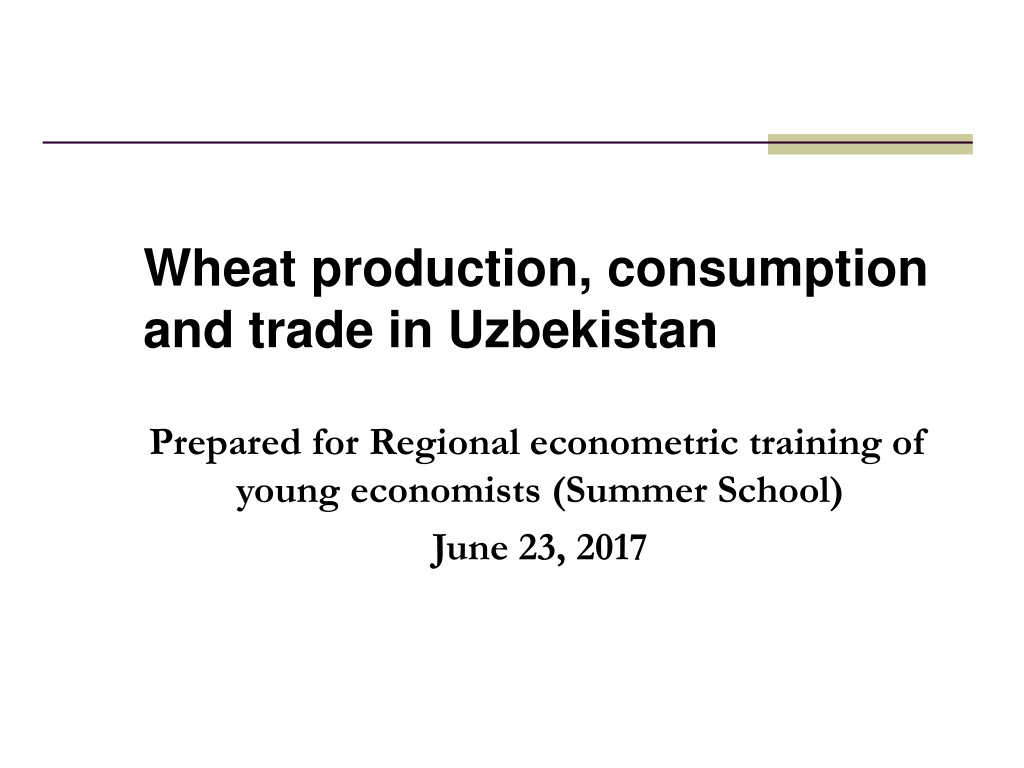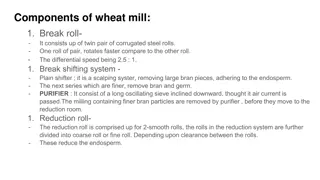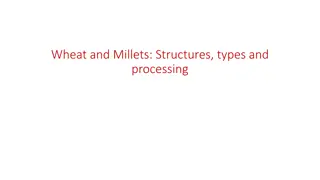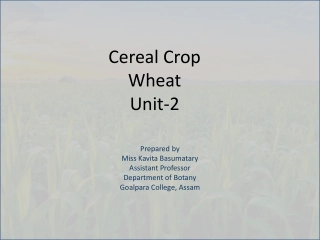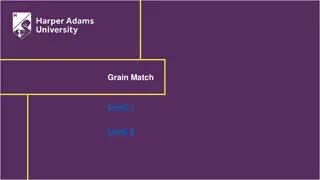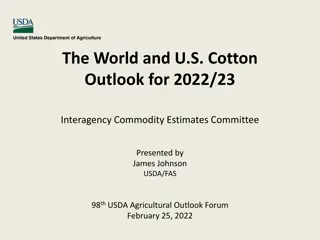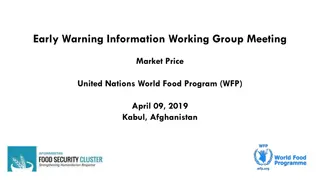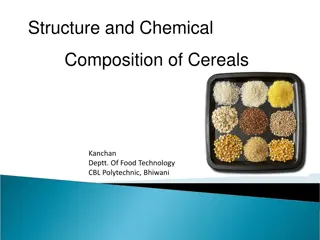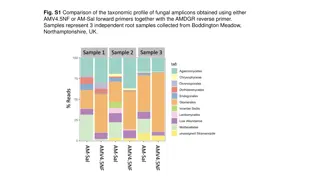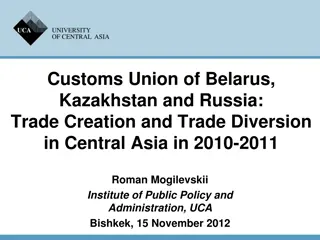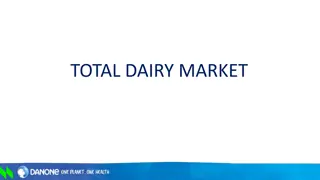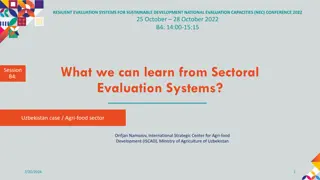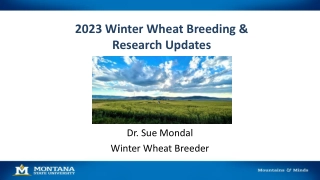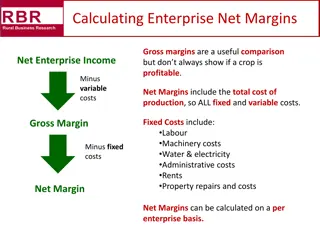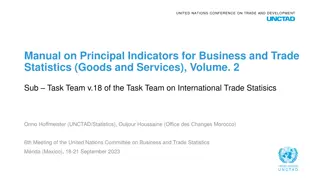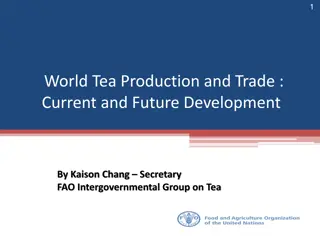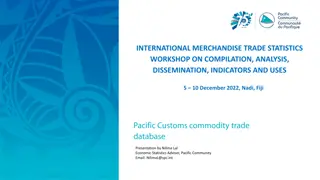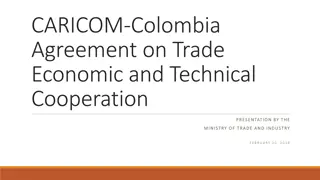Wheat Production, Consumption, and Trade in Uzbekistan: Policies and Trends
Wheat production in Uzbekistan plays a vital role in the country's economy, with bread being a staple food. The government's policies focus on achieving self-sufficiency in wheat while providing support to farmers. Despite challenges like underinvestment in agriculture, wheat production has significantly increased over the years. The state procurement system, subsidies, and support services contribute to improving wheat yields and food availability for the population.
Uploaded on Sep 20, 2024 | 0 Views
Download Presentation

Please find below an Image/Link to download the presentation.
The content on the website is provided AS IS for your information and personal use only. It may not be sold, licensed, or shared on other websites without obtaining consent from the author. Download presentation by click this link. If you encounter any issues during the download, it is possible that the publisher has removed the file from their server.
E N D
Presentation Transcript
Wheat production, consumption and trade in Uzbekistan Prepared for Regional econometric training of young economists (Summer School) June 23, 2017
Outline Production support policies Consumption of wheat Trade policies on wheat
Production support policies Wheat (bread) is the major staple food in Uzbekistan. It represents 90% of total cereal production the rest being rice, rye and barley. Agricultural policies on wheat of the Government of Uzbekistan are not consistent on the one hand, the Government is committed to wheat self-sufficiency, but on the other hand the state procurement system does not provide much incentives for farmers to increase yield It should be noted that due to chronic underinvestment into agriculture, its share in GDP has decreased from 30% in 2001 to 17% in 2015. Official statistics shows that less than 5% of all investments is invested into agriculture.
Production support policies Since early 2000s, growth rate of agricultural production has exceeded growth rate of population. As a result, production of agricultural produce per capita has increased. Production of wheat has rapidly increased from around 610,000 tons in 1991 to 2,347,000 tons in 1995. By 2013, production of wheat has reached 6.6 mln tons. Wheat yield has increased by 17% in the last 10 years, second lowest yield increase after cotton yield. Wheat and cotton have been subject to the state procurement, while other crops have not been subjected to it.
Table 1. Changes in harvested area, production, and yield for major agricultural commodities in Uzbekistan Area harvested ha, mean for 2011-2013 1428.8 1315.4 436.2 Production, mean 2011-2013 (000 mt) 6633.03 3440.43 3277.51 7759.93 138.75 2041.60 1423.83 261.90 291.70 % change in yield, 2004 2013 17% 5% 46% 64% 21% 46% 56% 74% 70% in for Yield (mt/ha), 2011-2013 4.64 2.62 7.51 42.43 1.70 26.86 28.44 5.48 8.65 to Wheat Cotton Fruits Vegetables 182.9 Barley Potatoes Melons Rice Maiz 81.8 76.0 50.1 47.8 33.7
Production supply policies The state buys almost all of the wheat produced by farmers at a fixed procurement price, which is much below the market price for domestic wheat and flour. Compared to the other strategic crop, cotton, wheat is harvested in June, allowing farmers to cultivate a second crop during the same year. In addition, wheat can be retained for own consumption of the farmers or sold in the domestic market, which is not the case for cotton. Hence wheat provides access to cash, a major production factor. Government also provides support to producers in the form of bank loans, seeds, fertilizers and pest control. Table 2 shows that as a result of improved yields, food availability has significantly improved.
Table 2. Per capita availability of main food products 2000 183.5 119.9 2005 234.7 145.4 2009 222.2 147.9 Wheat, kg Vegetables melons, kg Potatoes, kg Meat, kg Milk, liter and 29.75 20.9 147.8 32.7 23.1 158 34.9 24.5 173.8
Consumption of wheat in Uzbekistan Wheat and wheat products (flour, macaroni, and other products) constitute major part of Uzbek people s diet Table 3 shows there is a clear relationship between income level and consumption of meat, diary products, fruits and vegetables. It is worth mentioning that the poorest 20% of househods get 73% of their daily calorie intake from cereals, and primarily from wheat.
Table 3. Source of calories for different income groups ,% * 73,01 68,23 63,75 58,19 47,55 2,67 3,96 4,91 5,05 6,45 ** 7,76 9,76 12,12 15,21 22,06 2- 3- 4- 2,80 2,96 3,07 3,39 4,04 0,33 0,58 0,83 0,93 1,16 *) , **)
Wheat consumption The wheat consumption norm in Uzbekistan is 110 kg flour/person/year, or 147 kg wheat equivalent. However, data from household surveys indicates that actual consumption is much higher: some estimates put it between 167 and 180 kg bread (Cornia et al., 2003 and Christenson, 2003).
Looking forward This research will try to answer the question if the current system of wheat production, consumption and trade is the most optimal with regards to alternatives and sustainability in the long-run. Issues of production, processing, trade and consumption are intrinsically linked to each other and solutions should be comprehensive.
Wheat consumption Parpiev and Yusupov (2011) test an intriguing possibility that bread might be an inferior consumption good. To test this, Parpiev and Yusupov (2011) construct a Tobit estimation with bread as a dependent variable and per capita expenditures and household size as an explanatory variables among others. The results show that income elasticity of bread consumption for full sample, as well as for all four quartiles of population is consistently negative and statistically significant, indicating that bread is an inferior and income inelastic good (necessity). The inferior nature of bread in Uzbekistan means that people, especially the poorest households, might be consuming too much bread than they really would like. And when income increases, they will decrease their consumption of bread by substituting it away with other more desirable food.
Table 4. Tobit estimations: Dependent variable Bread Full sample Poorest 2nd quartile 3rd Richest quartile Log PCE -0.053*** -0.065** -0.078** -0.071*** -0.03*** [0.003] [0.029] [0.037] [0.022] [0.003] Log HH size -0.009** 0.010 -0.018 -0.018** - 0.007** [0.004] [0.021] [0.012] [0.008] [0.003]
Trade policies Trade regime of Uzbekistan is one of the most overregulated among all transition countries According to some estimates, a significant portion of demand for wheat (up to 47%) is covered by importing wheat from Kazakhstan and Russia. The Government regulates the trade in wheat by a combination of tariff and non-tariff barriers. The nature of such regulation has significantly changed after the global economic and financial crisis of 2008-09.
Trade policies Despite declaring self-sufficiency in wheat production and consumption, Uzbekistan has remained a big importer of wheat and flour from Kazakhstan and Russia. The overall assessment of the wheat self-sufficiency policy is not clear- cut and its success should be judged in connection with economic, political, social costs of the policy. For example, expanding wheat cultivation has greatly reduced the area devoted to other grains and fodder crops. This raises an interesting question if Uzbekistan possesses a comparative advantage in producing wheat at all. And whether the wheat self-sufficiency has affected supply to market of other food and fodder crops, with significant negative consequences for the population s diet and nutrition.
